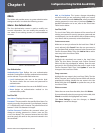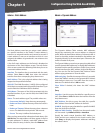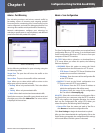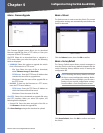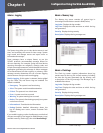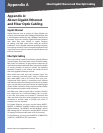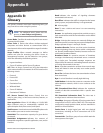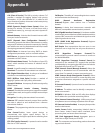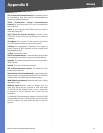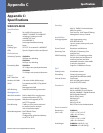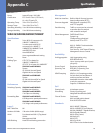
39
Glossary
Business Series Smart Gigabit Ethernet Switch
Appendix B
CoS (Class of Service) The 802.1p priority scheme. CoS
provides a method for tagging packets with priority
information. A CoS value between 0-7 is added to the
Layer II header of packets, where zero is the lowest priority
and seven is the highest.
DDNS (Dynamic Domain Name System) Allows the
hosting of a website, FTP server, or e-mail server with a
fixed domain name (e.g., www.xyz.com) and a dynamic IP
address.
Default Gateway A device that forwards Internet traffic
from your local area network.
DHCP (Dynamic Host Configuration Protocol) A
networking protocol that allows administrators to assign
temporary IP addresses to network computers by “leasing”
an IP address to a user for a limited amount of time, instead
of assigning permanent IP addresses.
DHCP Clients An Internet host using DHCP to obtain
configuration parameters, such as a network address.
DHCP Server An Internet host that returns configuration
parameters to DHCP clients.
DNS (Domain Name Server) The IP address of your ISP’s
server, which translates the names of websites into IP
addresses.
Domain A specific name for a network of computers.
Download To receive a file transmitted over a network.
DSL (Digital Subscriber Line) An always-on broadband
connection over traditional phone lines.
DSCP (DiffServ Code Point) Provides a method of
tagging IP packets with QoS priority information.
Dynamic IP Address A temporary IP address assigned by
a DHCP server.
EIGRP (Enhanced Interior Gateway Routing
Protocol) Provides fast convergence, support for variable-
length subnet mask, and supports multiple network layer
protocols.
Encryption Encoding data transmitted in a network.
Ethernet IEEE standard network protocol that specifies
how data is placed on and retrieved from a common
transmission medium.
Firmware The programming code that runs a networking
device.
Flow Control Enables lower speed devices to
communicate with higher speed devices. This is
implemented by the higher speed device refraining from
sending packets.
FTP (File Transfer Protocol) A protocol used to transfer
files over a TCP/IP network.
Full Duplex The ability of a networking device to receive
and transmit data simultaneously.
GARP (General Attributes Registration
Protocol) Registers client stations into a multicast
domain.
Gateway A device that interconnects networks with
different, incompatible communications protocols.
GBIC (GigaBit Interface Converter) A hardware module
used to attach network devices to fiber-based transmission
systems. GBIC converts the serial electrical signals to serial
optical signals and vice versa.
GVRP (GARP VLAN Registration Protocol) Registers
client stations into a VLANs.
Half Duplex Data transmission that can occur in two
directions over a single line, but only one direction at a
time.
HTTP (HyperText Transport Protocol) The
communications protocol used to connect to servers on
the World Wide Web.
HTTPS (HyperText Transport Protocol Secure) An
extension to the standard HTTP protocol that provides
confidentiality by encrypting the traffic from the website.
By default this protocol uses TCP port 443.
ICMP (Internet Control Message Protocol) Allows the
gateway or destination host to communicate with the
source host. For example, to report a processing error.
IGMP (Internet Group Management Protocol) Allows
hosts to notify their local switch or router that they want
to receive transmissions assigned to a specific multicast
group.
IP (Internet Protocol) A protocol used to send data over
a network.
IP Address The address used to identify a computer or
device on a network.
IPCONFIG A Windows 2000 and XP utility that displays
the IP address for a particular networking device.
IPSec (Internet Protocol Security) A VPN protocol used
to implement secure exchange of packets at the IP layer.
ISP (Internet Service Provider) A company that provides
access to the Internet.
Jumbo Frames Enable transporting identical data in
fewer frames. Jumbo Frames reduce overhead, lower
processing time, and ensure fewer interrupts.
LAG (Link Aggregated Group) Aggregates ports or
VLANs into a single virtual port or VLAN.
LAN The computers and networking products that make
up your local network.



